Value Proposition of All Seasons Knitwear: An Essay Analysis
VerifiedAdded on 2022/10/15
|8
|2698
|16
Essay
AI Summary
This essay provides a comprehensive analysis of All Seasons, a knitwear manufacturing company operating in Australia since 1962. It examines the company's value proposition, emphasizing its commitment to quality, sustainable practices, and ethical business procedures. The essay explores All Seasons' organizational structure, including the roles of various departments such as human resources, finance, and marketing, in contributing to customer value. It delves into the key elements of the value proposition model, including stakeholders, activities, and resources. The analysis highlights the company's focus on regenerative agriculture, waste management, and customer experience through innovative marketing techniques. The essay also discusses the importance of employees as key stakeholders and the impact of marketing and distribution channels on sales. Furthermore, it emphasizes the significance of financial resources and sustainable practices in creating a competitive advantage. The essay concludes by showcasing how All Seasons aligns its operations with a value-focused enterprise model, ensuring the delivery of quality products while minimizing environmental impact and maintaining a strong emphasis on stakeholder engagement.
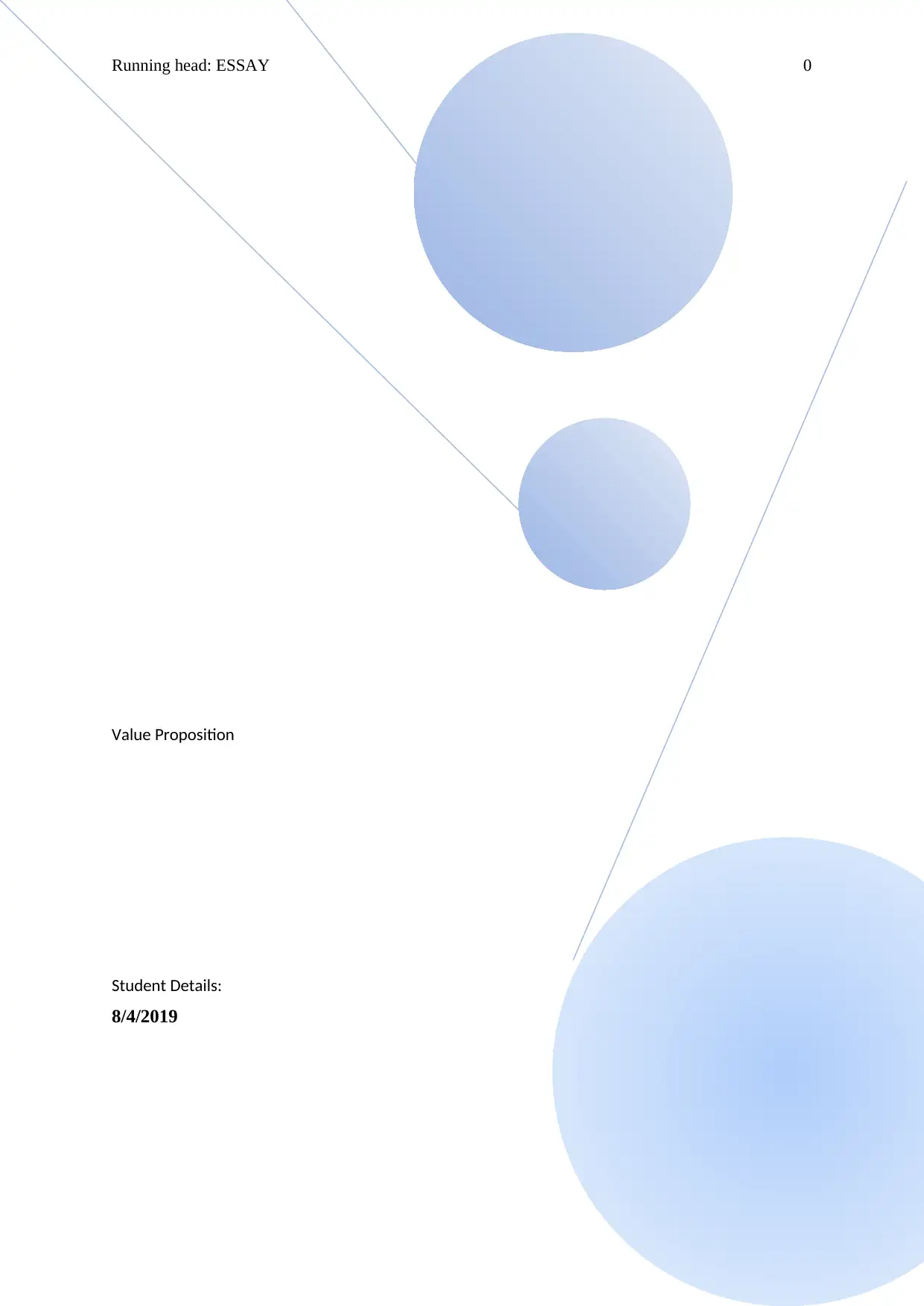
Running head: ESSAY 0
Value Proposition
Student Details:
8/4/2019
Value Proposition
Student Details:
8/4/2019
Paraphrase This Document
Need a fresh take? Get an instant paraphrase of this document with our AI Paraphraser
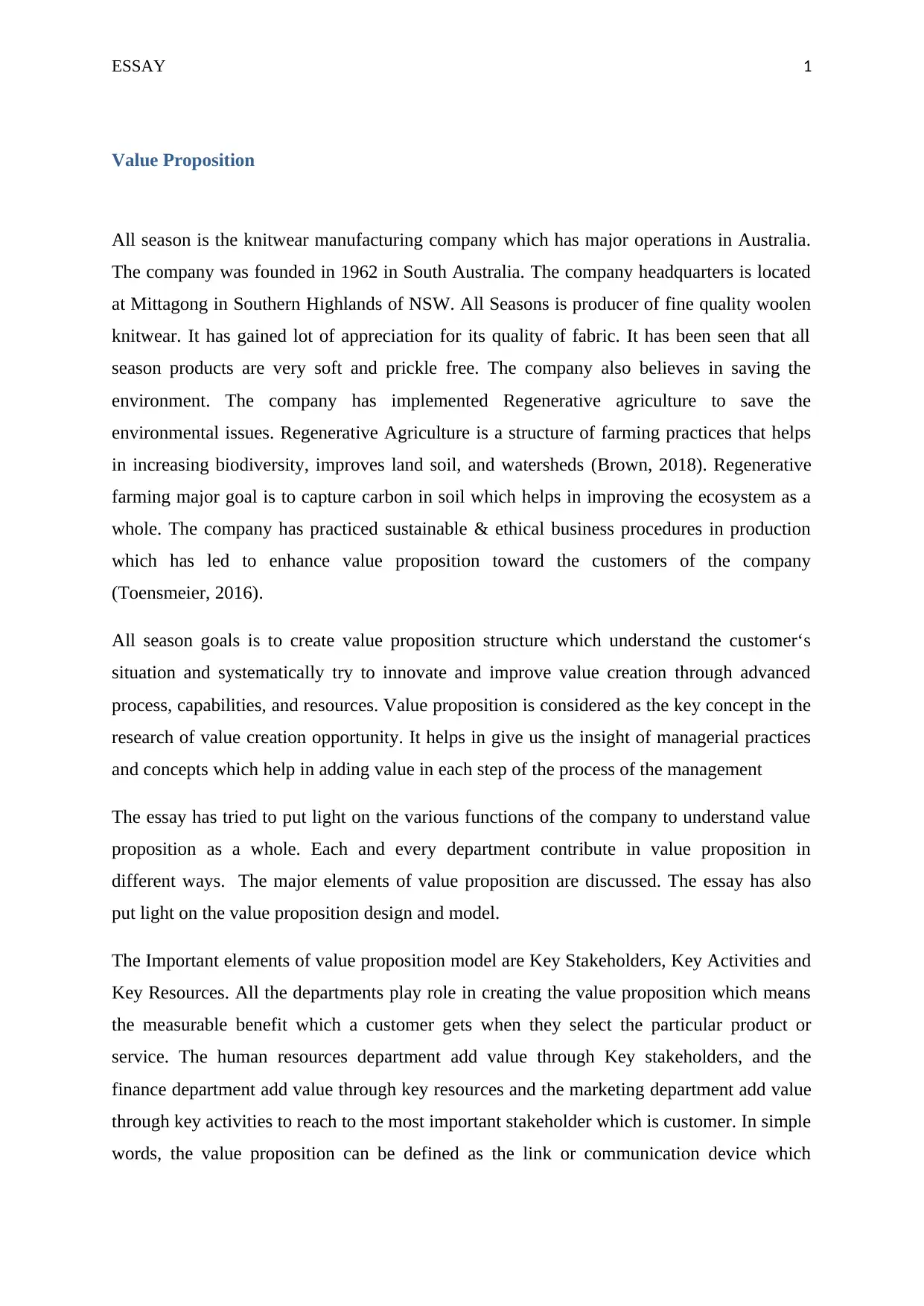
ESSAY 1
Value Proposition
All season is the knitwear manufacturing company which has major operations in Australia.
The company was founded in 1962 in South Australia. The company headquarters is located
at Mittagong in Southern Highlands of NSW. All Seasons is producer of fine quality woolen
knitwear. It has gained lot of appreciation for its quality of fabric. It has been seen that all
season products are very soft and prickle free. The company also believes in saving the
environment. The company has implemented Regenerative agriculture to save the
environmental issues. Regenerative Agriculture is a structure of farming practices that helps
in increasing biodiversity, improves land soil, and watersheds (Brown, 2018). Regenerative
farming major goal is to capture carbon in soil which helps in improving the ecosystem as a
whole. The company has practiced sustainable & ethical business procedures in production
which has led to enhance value proposition toward the customers of the company
(Toensmeier, 2016).
All season goals is to create value proposition structure which understand the customer‘s
situation and systematically try to innovate and improve value creation through advanced
process, capabilities, and resources. Value proposition is considered as the key concept in the
research of value creation opportunity. It helps in give us the insight of managerial practices
and concepts which help in adding value in each step of the process of the management
The essay has tried to put light on the various functions of the company to understand value
proposition as a whole. Each and every department contribute in value proposition in
different ways. The major elements of value proposition are discussed. The essay has also
put light on the value proposition design and model.
The Important elements of value proposition model are Key Stakeholders, Key Activities and
Key Resources. All the departments play role in creating the value proposition which means
the measurable benefit which a customer gets when they select the particular product or
service. The human resources department add value through Key stakeholders, and the
finance department add value through key resources and the marketing department add value
through key activities to reach to the most important stakeholder which is customer. In simple
words, the value proposition can be defined as the link or communication device which
Value Proposition
All season is the knitwear manufacturing company which has major operations in Australia.
The company was founded in 1962 in South Australia. The company headquarters is located
at Mittagong in Southern Highlands of NSW. All Seasons is producer of fine quality woolen
knitwear. It has gained lot of appreciation for its quality of fabric. It has been seen that all
season products are very soft and prickle free. The company also believes in saving the
environment. The company has implemented Regenerative agriculture to save the
environmental issues. Regenerative Agriculture is a structure of farming practices that helps
in increasing biodiversity, improves land soil, and watersheds (Brown, 2018). Regenerative
farming major goal is to capture carbon in soil which helps in improving the ecosystem as a
whole. The company has practiced sustainable & ethical business procedures in production
which has led to enhance value proposition toward the customers of the company
(Toensmeier, 2016).
All season goals is to create value proposition structure which understand the customer‘s
situation and systematically try to innovate and improve value creation through advanced
process, capabilities, and resources. Value proposition is considered as the key concept in the
research of value creation opportunity. It helps in give us the insight of managerial practices
and concepts which help in adding value in each step of the process of the management
The essay has tried to put light on the various functions of the company to understand value
proposition as a whole. Each and every department contribute in value proposition in
different ways. The major elements of value proposition are discussed. The essay has also
put light on the value proposition design and model.
The Important elements of value proposition model are Key Stakeholders, Key Activities and
Key Resources. All the departments play role in creating the value proposition which means
the measurable benefit which a customer gets when they select the particular product or
service. The human resources department add value through Key stakeholders, and the
finance department add value through key resources and the marketing department add value
through key activities to reach to the most important stakeholder which is customer. In simple
words, the value proposition can be defined as the link or communication device which
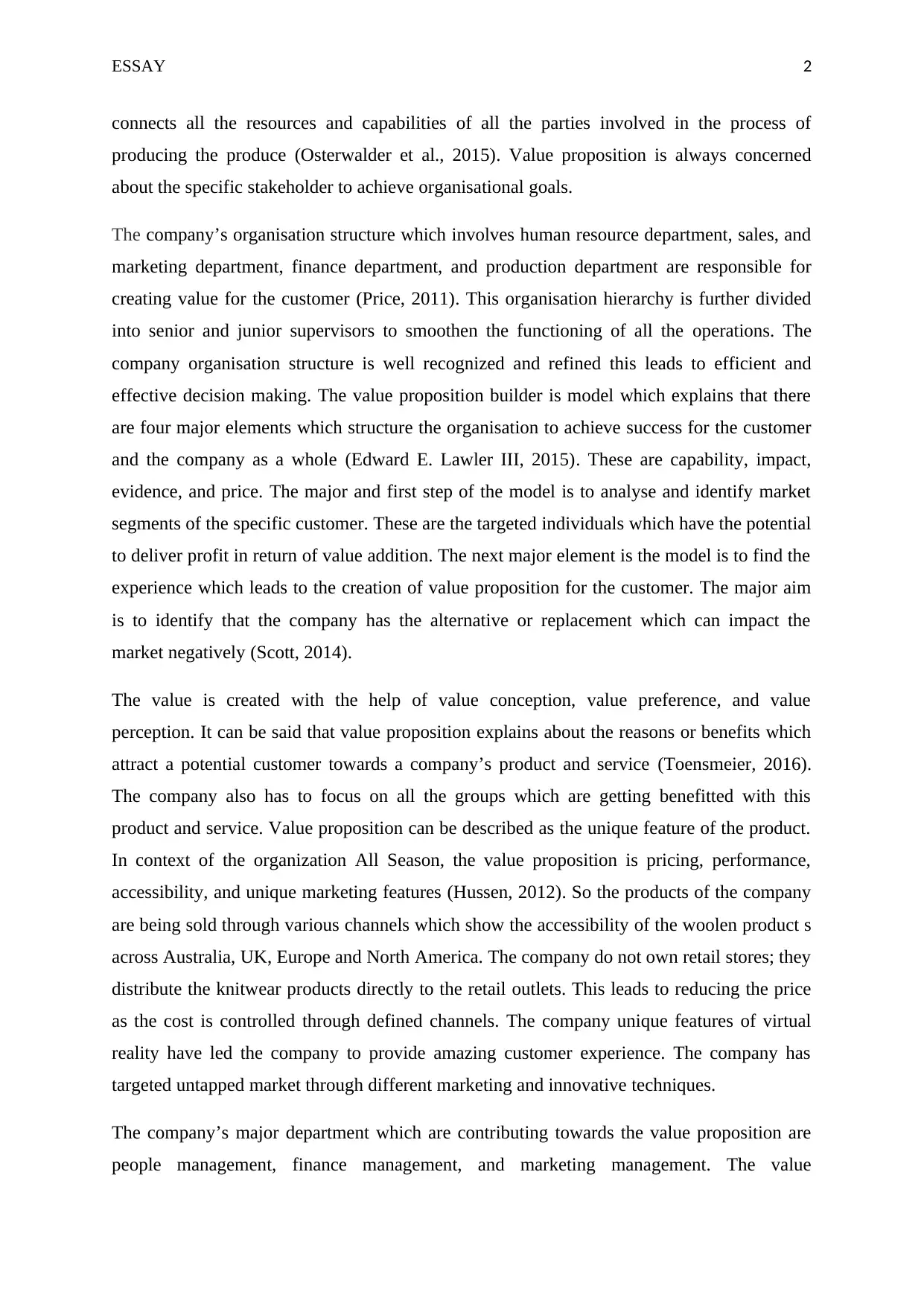
ESSAY 2
connects all the resources and capabilities of all the parties involved in the process of
producing the produce (Osterwalder et al., 2015). Value proposition is always concerned
about the specific stakeholder to achieve organisational goals.
The company’s organisation structure which involves human resource department, sales, and
marketing department, finance department, and production department are responsible for
creating value for the customer (Price, 2011). This organisation hierarchy is further divided
into senior and junior supervisors to smoothen the functioning of all the operations. The
company organisation structure is well recognized and refined this leads to efficient and
effective decision making. The value proposition builder is model which explains that there
are four major elements which structure the organisation to achieve success for the customer
and the company as a whole (Edward E. Lawler III, 2015). These are capability, impact,
evidence, and price. The major and first step of the model is to analyse and identify market
segments of the specific customer. These are the targeted individuals which have the potential
to deliver profit in return of value addition. The next major element is the model is to find the
experience which leads to the creation of value proposition for the customer. The major aim
is to identify that the company has the alternative or replacement which can impact the
market negatively (Scott, 2014).
The value is created with the help of value conception, value preference, and value
perception. It can be said that value proposition explains about the reasons or benefits which
attract a potential customer towards a company’s product and service (Toensmeier, 2016).
The company also has to focus on all the groups which are getting benefitted with this
product and service. Value proposition can be described as the unique feature of the product.
In context of the organization All Season, the value proposition is pricing, performance,
accessibility, and unique marketing features (Hussen, 2012). So the products of the company
are being sold through various channels which show the accessibility of the woolen product s
across Australia, UK, Europe and North America. The company do not own retail stores; they
distribute the knitwear products directly to the retail outlets. This leads to reducing the price
as the cost is controlled through defined channels. The company unique features of virtual
reality have led the company to provide amazing customer experience. The company has
targeted untapped market through different marketing and innovative techniques.
The company’s major department which are contributing towards the value proposition are
people management, finance management, and marketing management. The value
connects all the resources and capabilities of all the parties involved in the process of
producing the produce (Osterwalder et al., 2015). Value proposition is always concerned
about the specific stakeholder to achieve organisational goals.
The company’s organisation structure which involves human resource department, sales, and
marketing department, finance department, and production department are responsible for
creating value for the customer (Price, 2011). This organisation hierarchy is further divided
into senior and junior supervisors to smoothen the functioning of all the operations. The
company organisation structure is well recognized and refined this leads to efficient and
effective decision making. The value proposition builder is model which explains that there
are four major elements which structure the organisation to achieve success for the customer
and the company as a whole (Edward E. Lawler III, 2015). These are capability, impact,
evidence, and price. The major and first step of the model is to analyse and identify market
segments of the specific customer. These are the targeted individuals which have the potential
to deliver profit in return of value addition. The next major element is the model is to find the
experience which leads to the creation of value proposition for the customer. The major aim
is to identify that the company has the alternative or replacement which can impact the
market negatively (Scott, 2014).
The value is created with the help of value conception, value preference, and value
perception. It can be said that value proposition explains about the reasons or benefits which
attract a potential customer towards a company’s product and service (Toensmeier, 2016).
The company also has to focus on all the groups which are getting benefitted with this
product and service. Value proposition can be described as the unique feature of the product.
In context of the organization All Season, the value proposition is pricing, performance,
accessibility, and unique marketing features (Hussen, 2012). So the products of the company
are being sold through various channels which show the accessibility of the woolen product s
across Australia, UK, Europe and North America. The company do not own retail stores; they
distribute the knitwear products directly to the retail outlets. This leads to reducing the price
as the cost is controlled through defined channels. The company unique features of virtual
reality have led the company to provide amazing customer experience. The company has
targeted untapped market through different marketing and innovative techniques.
The company’s major department which are contributing towards the value proposition are
people management, finance management, and marketing management. The value
⊘ This is a preview!⊘
Do you want full access?
Subscribe today to unlock all pages.

Trusted by 1+ million students worldwide
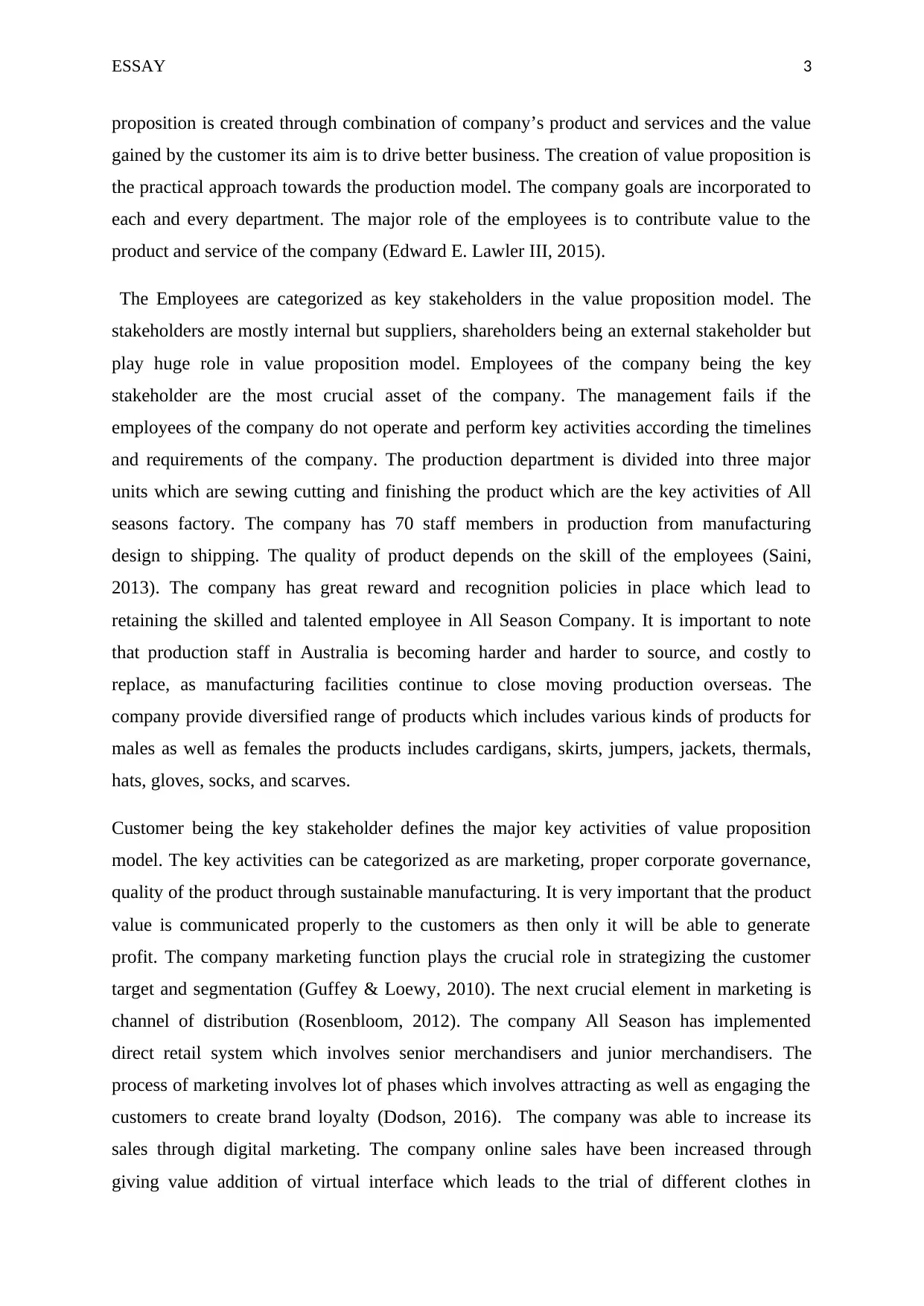
ESSAY 3
proposition is created through combination of company’s product and services and the value
gained by the customer its aim is to drive better business. The creation of value proposition is
the practical approach towards the production model. The company goals are incorporated to
each and every department. The major role of the employees is to contribute value to the
product and service of the company (Edward E. Lawler III, 2015).
The Employees are categorized as key stakeholders in the value proposition model. The
stakeholders are mostly internal but suppliers, shareholders being an external stakeholder but
play huge role in value proposition model. Employees of the company being the key
stakeholder are the most crucial asset of the company. The management fails if the
employees of the company do not operate and perform key activities according the timelines
and requirements of the company. The production department is divided into three major
units which are sewing cutting and finishing the product which are the key activities of All
seasons factory. The company has 70 staff members in production from manufacturing
design to shipping. The quality of product depends on the skill of the employees (Saini,
2013). The company has great reward and recognition policies in place which lead to
retaining the skilled and talented employee in All Season Company. It is important to note
that production staff in Australia is becoming harder and harder to source, and costly to
replace, as manufacturing facilities continue to close moving production overseas. The
company provide diversified range of products which includes various kinds of products for
males as well as females the products includes cardigans, skirts, jumpers, jackets, thermals,
hats, gloves, socks, and scarves.
Customer being the key stakeholder defines the major key activities of value proposition
model. The key activities can be categorized as are marketing, proper corporate governance,
quality of the product through sustainable manufacturing. It is very important that the product
value is communicated properly to the customers as then only it will be able to generate
profit. The company marketing function plays the crucial role in strategizing the customer
target and segmentation (Guffey & Loewy, 2010). The next crucial element in marketing is
channel of distribution (Rosenbloom, 2012). The company All Season has implemented
direct retail system which involves senior merchandisers and junior merchandisers. The
process of marketing involves lot of phases which involves attracting as well as engaging the
customers to create brand loyalty (Dodson, 2016). The company was able to increase its
sales through digital marketing. The company online sales have been increased through
giving value addition of virtual interface which leads to the trial of different clothes in
proposition is created through combination of company’s product and services and the value
gained by the customer its aim is to drive better business. The creation of value proposition is
the practical approach towards the production model. The company goals are incorporated to
each and every department. The major role of the employees is to contribute value to the
product and service of the company (Edward E. Lawler III, 2015).
The Employees are categorized as key stakeholders in the value proposition model. The
stakeholders are mostly internal but suppliers, shareholders being an external stakeholder but
play huge role in value proposition model. Employees of the company being the key
stakeholder are the most crucial asset of the company. The management fails if the
employees of the company do not operate and perform key activities according the timelines
and requirements of the company. The production department is divided into three major
units which are sewing cutting and finishing the product which are the key activities of All
seasons factory. The company has 70 staff members in production from manufacturing
design to shipping. The quality of product depends on the skill of the employees (Saini,
2013). The company has great reward and recognition policies in place which lead to
retaining the skilled and talented employee in All Season Company. It is important to note
that production staff in Australia is becoming harder and harder to source, and costly to
replace, as manufacturing facilities continue to close moving production overseas. The
company provide diversified range of products which includes various kinds of products for
males as well as females the products includes cardigans, skirts, jumpers, jackets, thermals,
hats, gloves, socks, and scarves.
Customer being the key stakeholder defines the major key activities of value proposition
model. The key activities can be categorized as are marketing, proper corporate governance,
quality of the product through sustainable manufacturing. It is very important that the product
value is communicated properly to the customers as then only it will be able to generate
profit. The company marketing function plays the crucial role in strategizing the customer
target and segmentation (Guffey & Loewy, 2010). The next crucial element in marketing is
channel of distribution (Rosenbloom, 2012). The company All Season has implemented
direct retail system which involves senior merchandisers and junior merchandisers. The
process of marketing involves lot of phases which involves attracting as well as engaging the
customers to create brand loyalty (Dodson, 2016). The company was able to increase its
sales through digital marketing. The company online sales have been increased through
giving value addition of virtual interface which leads to the trial of different clothes in
Paraphrase This Document
Need a fresh take? Get an instant paraphrase of this document with our AI Paraphraser
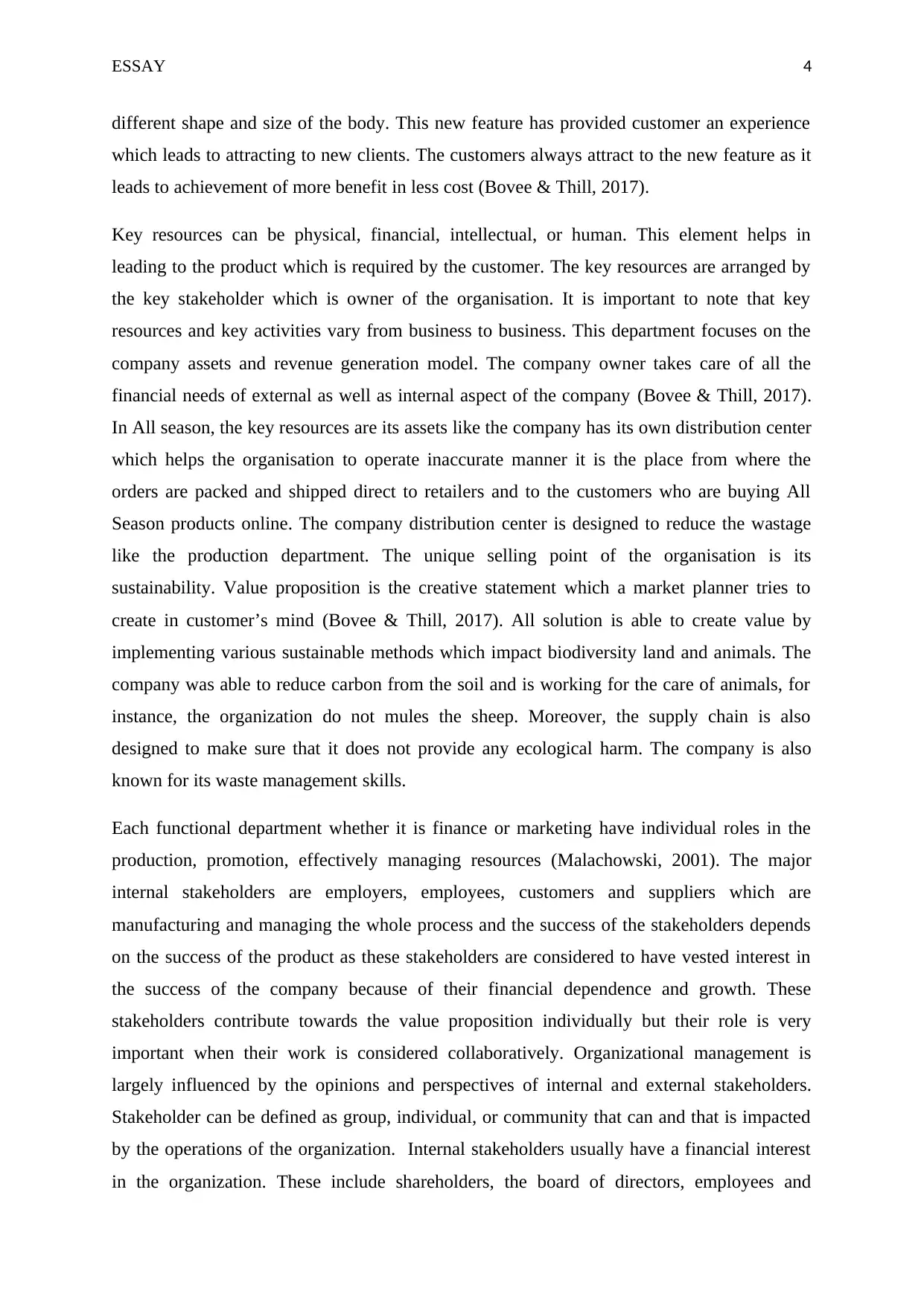
ESSAY 4
different shape and size of the body. This new feature has provided customer an experience
which leads to attracting to new clients. The customers always attract to the new feature as it
leads to achievement of more benefit in less cost (Bovee & Thill, 2017).
Key resources can be physical, financial, intellectual, or human. This element helps in
leading to the product which is required by the customer. The key resources are arranged by
the key stakeholder which is owner of the organisation. It is important to note that key
resources and key activities vary from business to business. This department focuses on the
company assets and revenue generation model. The company owner takes care of all the
financial needs of external as well as internal aspect of the company (Bovee & Thill, 2017).
In All season, the key resources are its assets like the company has its own distribution center
which helps the organisation to operate inaccurate manner it is the place from where the
orders are packed and shipped direct to retailers and to the customers who are buying All
Season products online. The company distribution center is designed to reduce the wastage
like the production department. The unique selling point of the organisation is its
sustainability. Value proposition is the creative statement which a market planner tries to
create in customer’s mind (Bovee & Thill, 2017). All solution is able to create value by
implementing various sustainable methods which impact biodiversity land and animals. The
company was able to reduce carbon from the soil and is working for the care of animals, for
instance, the organization do not mules the sheep. Moreover, the supply chain is also
designed to make sure that it does not provide any ecological harm. The company is also
known for its waste management skills.
Each functional department whether it is finance or marketing have individual roles in the
production, promotion, effectively managing resources (Malachowski, 2001). The major
internal stakeholders are employers, employees, customers and suppliers which are
manufacturing and managing the whole process and the success of the stakeholders depends
on the success of the product as these stakeholders are considered to have vested interest in
the success of the company because of their financial dependence and growth. These
stakeholders contribute towards the value proposition individually but their role is very
important when their work is considered collaboratively. Organizational management is
largely influenced by the opinions and perspectives of internal and external stakeholders.
Stakeholder can be defined as group, individual, or community that can and that is impacted
by the operations of the organization. Internal stakeholders usually have a financial interest
in the organization. These include shareholders, the board of directors, employees and
different shape and size of the body. This new feature has provided customer an experience
which leads to attracting to new clients. The customers always attract to the new feature as it
leads to achievement of more benefit in less cost (Bovee & Thill, 2017).
Key resources can be physical, financial, intellectual, or human. This element helps in
leading to the product which is required by the customer. The key resources are arranged by
the key stakeholder which is owner of the organisation. It is important to note that key
resources and key activities vary from business to business. This department focuses on the
company assets and revenue generation model. The company owner takes care of all the
financial needs of external as well as internal aspect of the company (Bovee & Thill, 2017).
In All season, the key resources are its assets like the company has its own distribution center
which helps the organisation to operate inaccurate manner it is the place from where the
orders are packed and shipped direct to retailers and to the customers who are buying All
Season products online. The company distribution center is designed to reduce the wastage
like the production department. The unique selling point of the organisation is its
sustainability. Value proposition is the creative statement which a market planner tries to
create in customer’s mind (Bovee & Thill, 2017). All solution is able to create value by
implementing various sustainable methods which impact biodiversity land and animals. The
company was able to reduce carbon from the soil and is working for the care of animals, for
instance, the organization do not mules the sheep. Moreover, the supply chain is also
designed to make sure that it does not provide any ecological harm. The company is also
known for its waste management skills.
Each functional department whether it is finance or marketing have individual roles in the
production, promotion, effectively managing resources (Malachowski, 2001). The major
internal stakeholders are employers, employees, customers and suppliers which are
manufacturing and managing the whole process and the success of the stakeholders depends
on the success of the product as these stakeholders are considered to have vested interest in
the success of the company because of their financial dependence and growth. These
stakeholders contribute towards the value proposition individually but their role is very
important when their work is considered collaboratively. Organizational management is
largely influenced by the opinions and perspectives of internal and external stakeholders.
Stakeholder can be defined as group, individual, or community that can and that is impacted
by the operations of the organization. Internal stakeholders usually have a financial interest
in the organization. These include shareholders, the board of directors, employees and
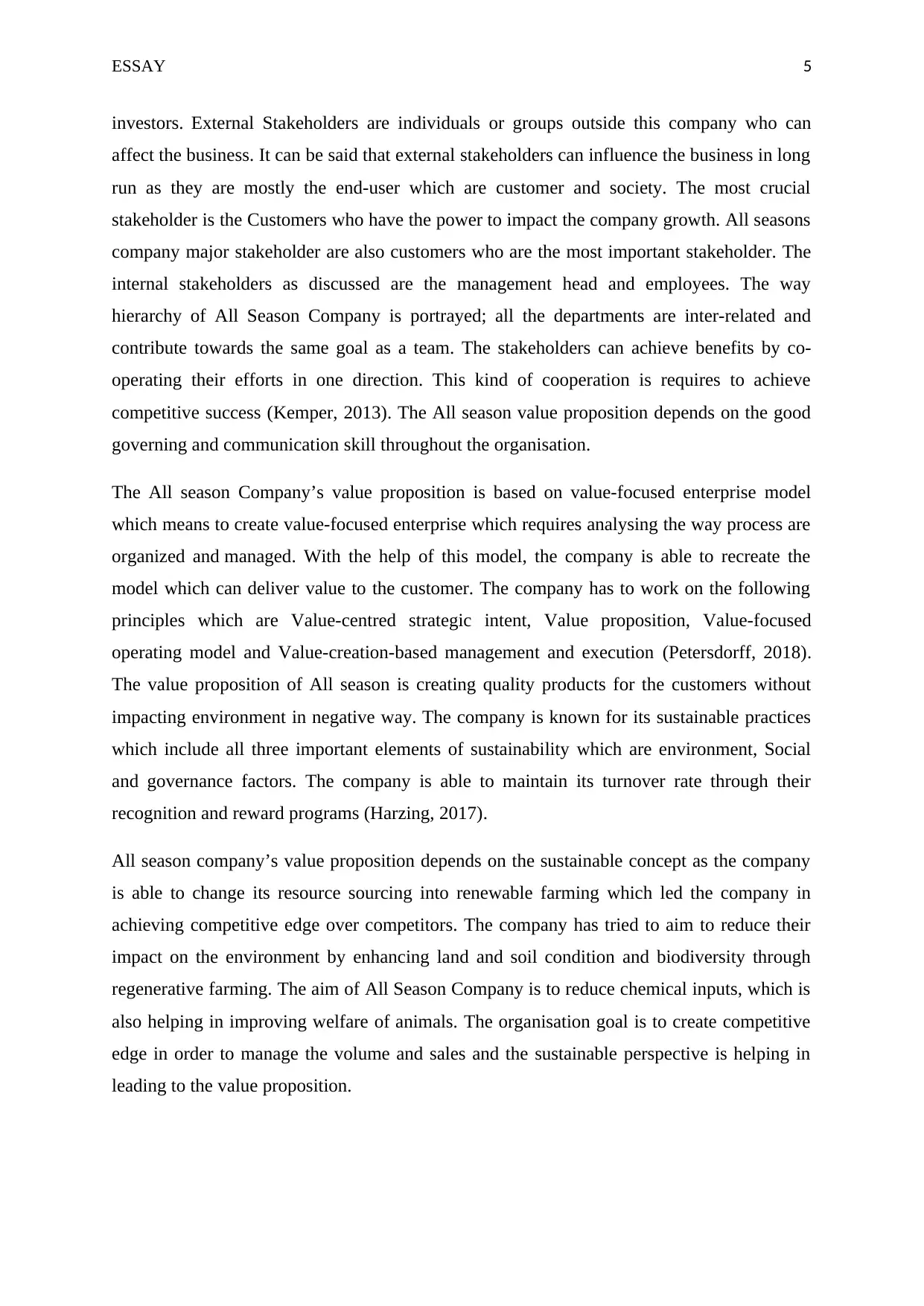
ESSAY 5
investors. External Stakeholders are individuals or groups outside this company who can
affect the business. It can be said that external stakeholders can influence the business in long
run as they are mostly the end-user which are customer and society. The most crucial
stakeholder is the Customers who have the power to impact the company growth. All seasons
company major stakeholder are also customers who are the most important stakeholder. The
internal stakeholders as discussed are the management head and employees. The way
hierarchy of All Season Company is portrayed; all the departments are inter-related and
contribute towards the same goal as a team. The stakeholders can achieve benefits by co-
operating their efforts in one direction. This kind of cooperation is requires to achieve
competitive success (Kemper, 2013). The All season value proposition depends on the good
governing and communication skill throughout the organisation.
The All season Company’s value proposition is based on value-focused enterprise model
which means to create value-focused enterprise which requires analysing the way process are
organized and managed. With the help of this model, the company is able to recreate the
model which can deliver value to the customer. The company has to work on the following
principles which are Value-centred strategic intent, Value proposition, Value-focused
operating model and Value-creation-based management and execution (Petersdorff, 2018).
The value proposition of All season is creating quality products for the customers without
impacting environment in negative way. The company is known for its sustainable practices
which include all three important elements of sustainability which are environment, Social
and governance factors. The company is able to maintain its turnover rate through their
recognition and reward programs (Harzing, 2017).
All season company’s value proposition depends on the sustainable concept as the company
is able to change its resource sourcing into renewable farming which led the company in
achieving competitive edge over competitors. The company has tried to aim to reduce their
impact on the environment by enhancing land and soil condition and biodiversity through
regenerative farming. The aim of All Season Company is to reduce chemical inputs, which is
also helping in improving welfare of animals. The organisation goal is to create competitive
edge in order to manage the volume and sales and the sustainable perspective is helping in
leading to the value proposition.
investors. External Stakeholders are individuals or groups outside this company who can
affect the business. It can be said that external stakeholders can influence the business in long
run as they are mostly the end-user which are customer and society. The most crucial
stakeholder is the Customers who have the power to impact the company growth. All seasons
company major stakeholder are also customers who are the most important stakeholder. The
internal stakeholders as discussed are the management head and employees. The way
hierarchy of All Season Company is portrayed; all the departments are inter-related and
contribute towards the same goal as a team. The stakeholders can achieve benefits by co-
operating their efforts in one direction. This kind of cooperation is requires to achieve
competitive success (Kemper, 2013). The All season value proposition depends on the good
governing and communication skill throughout the organisation.
The All season Company’s value proposition is based on value-focused enterprise model
which means to create value-focused enterprise which requires analysing the way process are
organized and managed. With the help of this model, the company is able to recreate the
model which can deliver value to the customer. The company has to work on the following
principles which are Value-centred strategic intent, Value proposition, Value-focused
operating model and Value-creation-based management and execution (Petersdorff, 2018).
The value proposition of All season is creating quality products for the customers without
impacting environment in negative way. The company is known for its sustainable practices
which include all three important elements of sustainability which are environment, Social
and governance factors. The company is able to maintain its turnover rate through their
recognition and reward programs (Harzing, 2017).
All season company’s value proposition depends on the sustainable concept as the company
is able to change its resource sourcing into renewable farming which led the company in
achieving competitive edge over competitors. The company has tried to aim to reduce their
impact on the environment by enhancing land and soil condition and biodiversity through
regenerative farming. The aim of All Season Company is to reduce chemical inputs, which is
also helping in improving welfare of animals. The organisation goal is to create competitive
edge in order to manage the volume and sales and the sustainable perspective is helping in
leading to the value proposition.
⊘ This is a preview!⊘
Do you want full access?
Subscribe today to unlock all pages.

Trusted by 1+ million students worldwide
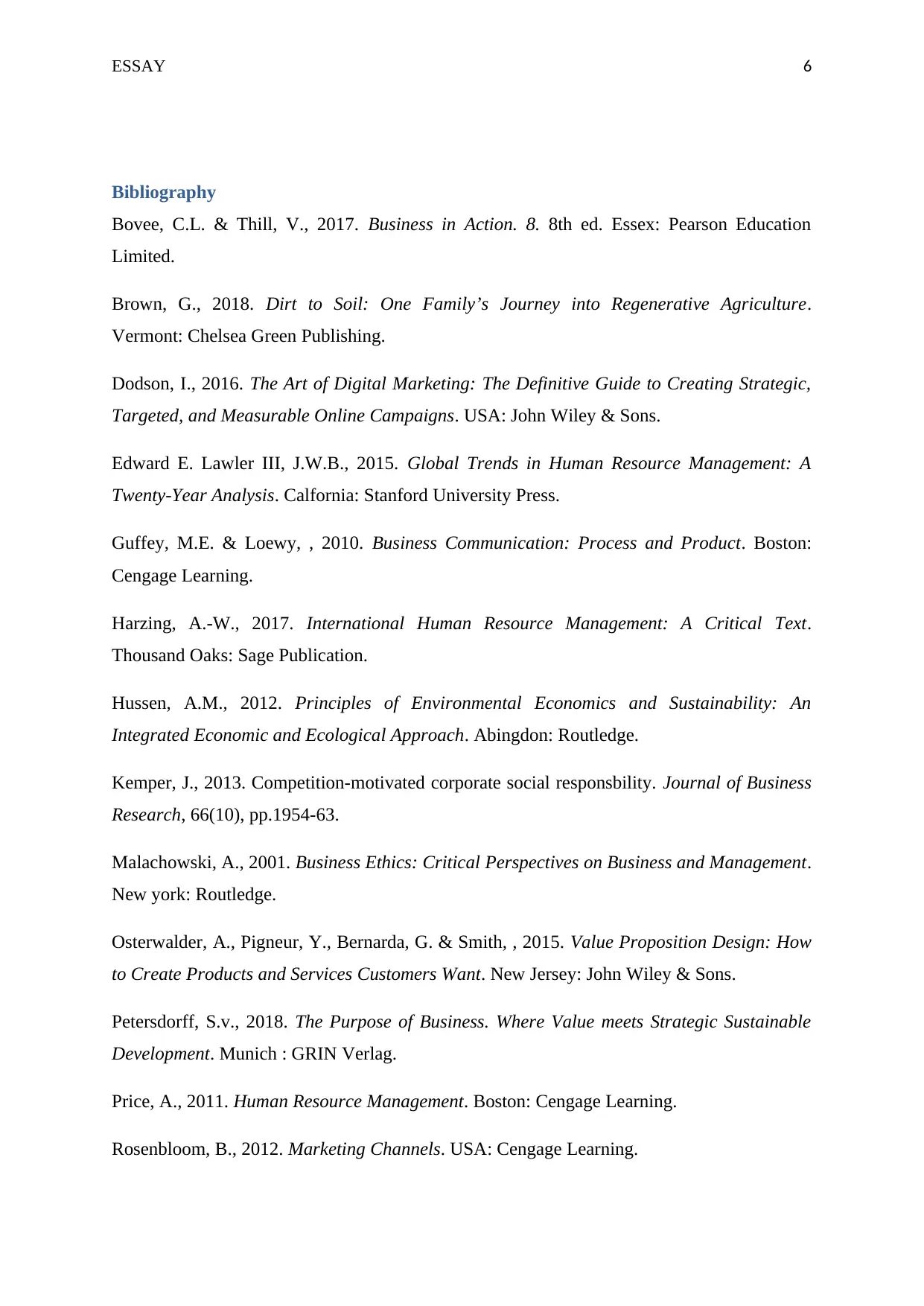
ESSAY 6
Bibliography
Bovee, C.L. & Thill, V., 2017. Business in Action. 8. 8th ed. Essex: Pearson Education
Limited.
Brown, G., 2018. Dirt to Soil: One Family’s Journey into Regenerative Agriculture.
Vermont: Chelsea Green Publishing.
Dodson, I., 2016. The Art of Digital Marketing: The Definitive Guide to Creating Strategic,
Targeted, and Measurable Online Campaigns. USA: John Wiley & Sons.
Edward E. Lawler III, J.W.B., 2015. Global Trends in Human Resource Management: A
Twenty-Year Analysis. Calfornia: Stanford University Press.
Guffey, M.E. & Loewy, , 2010. Business Communication: Process and Product. Boston:
Cengage Learning.
Harzing, A.-W., 2017. International Human Resource Management: A Critical Text.
Thousand Oaks: Sage Publication.
Hussen, A.M., 2012. Principles of Environmental Economics and Sustainability: An
Integrated Economic and Ecological Approach. Abingdon: Routledge.
Kemper, J., 2013. Competition-motivated corporate social responsbility. Journal of Business
Research, 66(10), pp.1954-63.
Malachowski, A., 2001. Business Ethics: Critical Perspectives on Business and Management.
New york: Routledge.
Osterwalder, A., Pigneur, Y., Bernarda, G. & Smith, , 2015. Value Proposition Design: How
to Create Products and Services Customers Want. New Jersey: John Wiley & Sons.
Petersdorff, S.v., 2018. The Purpose of Business. Where Value meets Strategic Sustainable
Development. Munich : GRIN Verlag.
Price, A., 2011. Human Resource Management. Boston: Cengage Learning.
Rosenbloom, B., 2012. Marketing Channels. USA: Cengage Learning.
Bibliography
Bovee, C.L. & Thill, V., 2017. Business in Action. 8. 8th ed. Essex: Pearson Education
Limited.
Brown, G., 2018. Dirt to Soil: One Family’s Journey into Regenerative Agriculture.
Vermont: Chelsea Green Publishing.
Dodson, I., 2016. The Art of Digital Marketing: The Definitive Guide to Creating Strategic,
Targeted, and Measurable Online Campaigns. USA: John Wiley & Sons.
Edward E. Lawler III, J.W.B., 2015. Global Trends in Human Resource Management: A
Twenty-Year Analysis. Calfornia: Stanford University Press.
Guffey, M.E. & Loewy, , 2010. Business Communication: Process and Product. Boston:
Cengage Learning.
Harzing, A.-W., 2017. International Human Resource Management: A Critical Text.
Thousand Oaks: Sage Publication.
Hussen, A.M., 2012. Principles of Environmental Economics and Sustainability: An
Integrated Economic and Ecological Approach. Abingdon: Routledge.
Kemper, J., 2013. Competition-motivated corporate social responsbility. Journal of Business
Research, 66(10), pp.1954-63.
Malachowski, A., 2001. Business Ethics: Critical Perspectives on Business and Management.
New york: Routledge.
Osterwalder, A., Pigneur, Y., Bernarda, G. & Smith, , 2015. Value Proposition Design: How
to Create Products and Services Customers Want. New Jersey: John Wiley & Sons.
Petersdorff, S.v., 2018. The Purpose of Business. Where Value meets Strategic Sustainable
Development. Munich : GRIN Verlag.
Price, A., 2011. Human Resource Management. Boston: Cengage Learning.
Rosenbloom, B., 2012. Marketing Channels. USA: Cengage Learning.
Paraphrase This Document
Need a fresh take? Get an instant paraphrase of this document with our AI Paraphraser
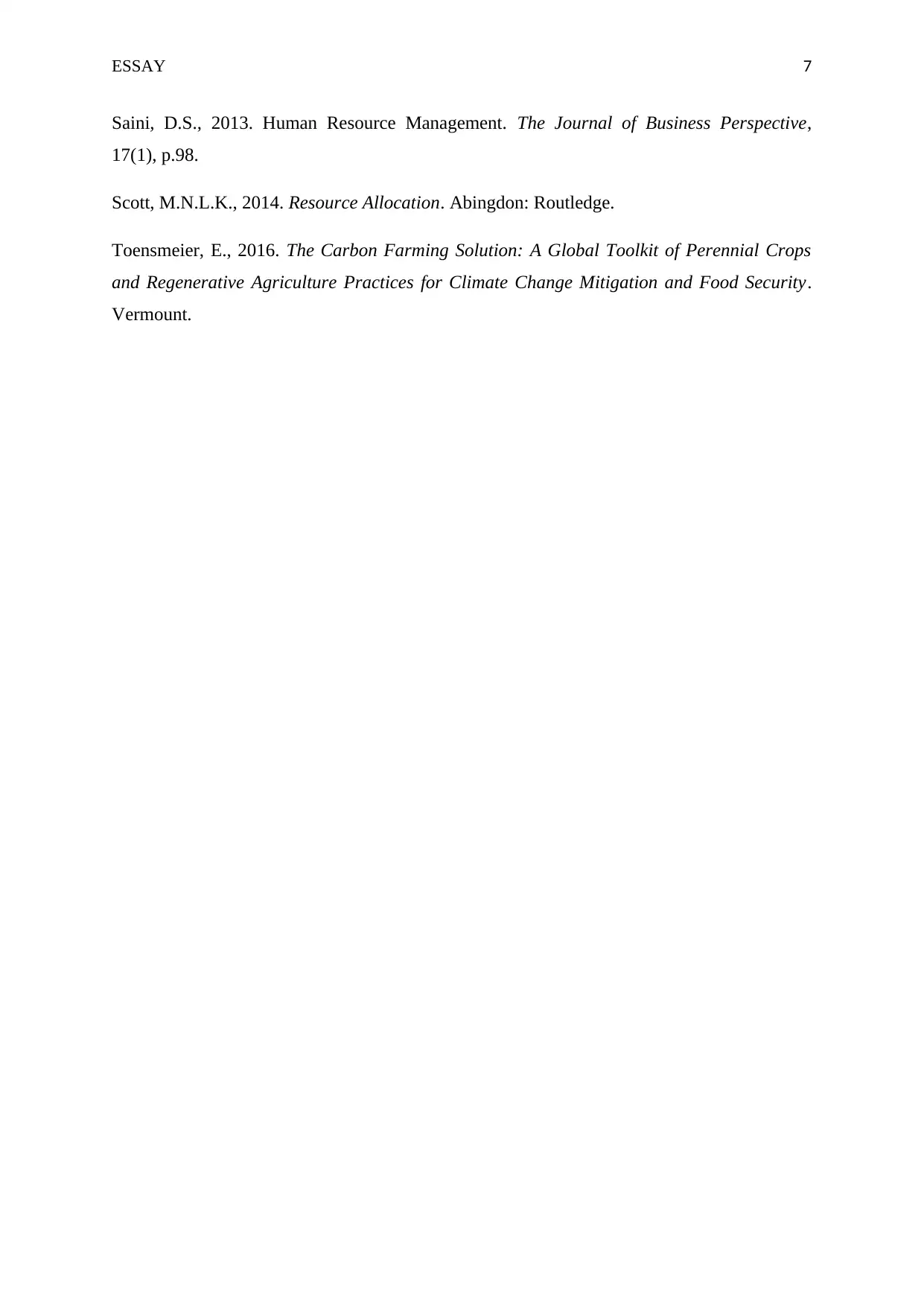
ESSAY 7
Saini, D.S., 2013. Human Resource Management. The Journal of Business Perspective,
17(1), p.98.
Scott, M.N.L.K., 2014. Resource Allocation. Abingdon: Routledge.
Toensmeier, E., 2016. The Carbon Farming Solution: A Global Toolkit of Perennial Crops
and Regenerative Agriculture Practices for Climate Change Mitigation and Food Security.
Vermount.
Saini, D.S., 2013. Human Resource Management. The Journal of Business Perspective,
17(1), p.98.
Scott, M.N.L.K., 2014. Resource Allocation. Abingdon: Routledge.
Toensmeier, E., 2016. The Carbon Farming Solution: A Global Toolkit of Perennial Crops
and Regenerative Agriculture Practices for Climate Change Mitigation and Food Security.
Vermount.
1 out of 8
Related Documents
Your All-in-One AI-Powered Toolkit for Academic Success.
+13062052269
info@desklib.com
Available 24*7 on WhatsApp / Email
![[object Object]](/_next/static/media/star-bottom.7253800d.svg)
Unlock your academic potential
Copyright © 2020–2025 A2Z Services. All Rights Reserved. Developed and managed by ZUCOL.





